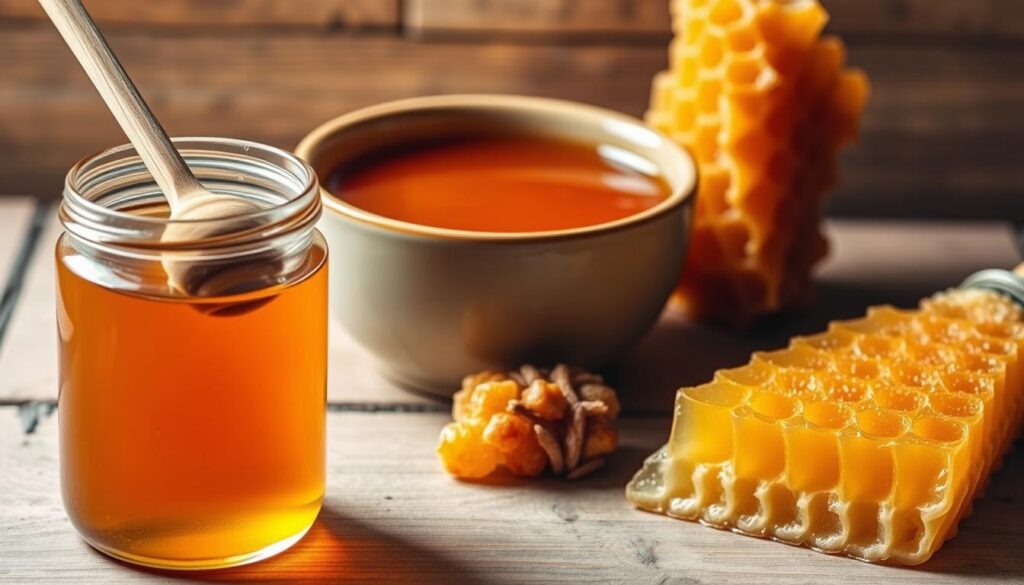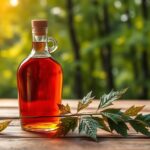Finding the right natural sweetener can change how you cook and eat. Maple syrup is a standout choice. It offers a mix of taste, nutrition, and uses that honey can’t match.
For years, maple syrup has won over many in North America. It comes from the tall maple trees of Vermont, Quebec, and more. This syrup is more than a sweetener; it’s a piece of history and a link to nature.
Maple syrup is a top pick for natural sweeteners. Its taste can be light or strong, depending on when it’s picked and the tree type. Unlike regular sugar, it also has health benefits that people looking for natural options want.
Maple syrup makers tap trees in late winter and early spring. They collect sap that turns into the syrup we love. This careful process keeps the syrup’s true taste and health benefits, making it a great choice for those who want a natural sweetener.
Nutrition experts and food lovers see maple syrup as more than just for breakfast. It has antioxidants and minerals, making it a better choice than honey for some.
In this guide, we’ll dive into the world of maple syrup. You’ll see why it might be the natural sweetener you’ve been looking for. It’s a journey into tasty, healthy, and sustainable eating.
Understanding Natural Sweeteners: A Comprehensive Overview
Natural sweeteners are a great choice over refined sugars. They offer unique health benefits and taste. These plant-based options add sweetness and extra health perks.
Exploring natural sweeteners opens up a world of tasty and healthy choices. Each one has special qualities that make them great for today’s diets.
Diverse Types of Natural Sweeteners
- Maple Syrup: Rich in minerals and antioxidants
- Honey: Antibacterial and enzymatically complex
- Agave Nectar: Low glycemic index sweetener
- Stevia: Zero-calorie plant-based option
- Coconut Sugar: Minimally processed with trace nutrients
Historical Cultural Significance
Natural sweeteners have deep roots in cultures around the world. Native American tribes started making maple syrup. Mesoamerican civilizations grew agave for ages.
| Natural Sweetener | Origin Region | Traditional Use |
|---|---|---|
| Maple Syrup | North America | Ceremonial and nutritional sustenance |
| Honey | Global | Medicinal and culinary purposes |
| Agave Nectar | Mexico | Ritual drink and sweetener |
Modern Applications and Trends
Today, people are looking for natural sweeteners as a healthier choice. They see these options as more than just sweet. They offer nutrition and rich flavors.
Studies show more people want natural, nutrient-rich sweeteners. They support health and sustainable food practices.
The Production Process: From Tree to Table
Maple syrup production is a journey that shows how Sustainable Farming connects us to nature. It starts in late winter when sugarmakers get ready to tap their maple forests.
Traditional maple syrup production has several key steps:
- Tree Selection: Finding healthy maple trees that are 40+ years old
- Tapping: Drilling small holes into the maple tree bark
- Sap Collection: Gathering raw sap using tubes or traditional buckets
- Boiling: Turning the sap into concentrated syrup
Local Produce fans love the skill that goes into making maple syrup. Turning tree sap into golden syrup takes a lot of precision and patience.
“Maple syrup production is an art passed down through generations, connecting us directly to the forest’s natural rhythms.” – Vermont Maple Sugar Makers Association
Today, sustainable farming has made traditional methods better. Sugarmakers use new tech to collect sap better while keeping the forest healthy. They work hard to keep the forest balanced and the trees healthy for the future.
The whole process takes 4-6 weeks, with the busiest time from February to March. Each maple tree gives about 10-20 gallons of sap a year. This makes just one quart of pure maple syrup.
Maple Syrup Better than Honey: A Direct Comparison
Natural sweeteners like maple syrup and honey are popular for those who want to avoid refined sugar. Each has its own benefits for a healthy diet.
Looking into the Maple Syrup Better than Honey debate, we find some key differences.
Taste Profile Analysis
Maple syrup has a rich, complex taste with notes of the woods. Its flavor can be light or strong, depending on when it’s harvested. Honey, on the other hand, tastes floral and can change based on where the bees get their nectar.
- Maple Syrup: Caramel-like, woody undertones
- Honey: Floral, varying by bee region
- Intensity: Maple syrup provides more consistent flavor
Nutritional Content Breakdown
Maple syrup has more minerals and antioxidants than honey. This makes it a better choice for those looking for nutritional benefits.
| Nutrient | Maple Syrup | Honey |
|---|---|---|
| Manganese | 33% Daily Value | 2% Daily Value |
| Zinc | 7% Daily Value | 1% Daily Value |
| Antioxidants | Higher concentration | Lower concentration |
Cost and Availability Factors
Maple syrup is pricier because making it is hard work. Small-batch producers put a lot of effort into harvesting it.
“Maple syrup represents not just a sweetener, but a craft passed through generations of dedicated producers.” – Maple Farming Association
Even though honey is easier to find, maple syrup’s unique taste and health benefits are making it more popular. It’s a choice for those who want the best.
Essential Nutrients Found in Pure Maple Syrup
Pure maple syrup is more than a sweet treat. It’s packed with essential nutrients, making it a healthier choice than refined sugars. Unlike processed sugars, maple syrup has a rich mix of minerals and beneficial compounds.
Maple syrup’s nutritional benefits go beyond its taste. It contains several key nutrients:
- Manganese: Supports bone health and metabolism
- Zinc: Boosts immune system function
- Calcium: Promotes strong bones and teeth
- Potassium: Helps regulate heart and muscle function
Maple syrup has about 24 different antioxidants. These antioxidants protect the body from damage. They are similar to those in berries and other nutrient-rich foods, making maple syrup a special sweetener.
The nutritional content varies with the maple syrup grade. Darker grades have more minerals and antioxidants. This makes maple syrup a valuable addition to your diet, not just a sweetener.
A single tablespoon of pure maple syrup has more nutritional value than many other sweeteners. It’s a natural and wholesome alternative to processed sugar.
While maple syrup should be enjoyed in moderation, it’s a better choice than traditional sweeteners. Its mix of essential minerals and antioxidants makes it a great addition to a balanced diet.
Antioxidant Properties and Health Benefits
Maple syrup is a Healthy Alternative to regular sweeteners. It’s not just sweet; it’s packed with antioxidants. This makes it a great choice for those who care about their health.
Maple syrup is full of antioxidants. This is different from refined sugars. It has many good compounds that help keep you healthy.
Key Antioxidant Compounds
Scientists have found important antioxidants in maple syrup. These include:
- Quebecol: A unique antioxidant found only in maple syrup
- Phenolic compounds that fight cellular damage
- Polyphenols that help reduce inflammation
Impact on Overall Wellness
Maple syrup does more than just taste good. It may help improve how your body works and protect your cells.
“Maple syrup is more than a sweetener—it’s a natural wellness ingredient with amazing benefits.” – Dr. Sarah Richards, Nutritional Scientist
Scientific Research Findings
Recent studies show maple syrup’s health benefits. They found that its antioxidants may:
- Lessen oxidative stress
- Help your heart stay healthy
- Boost your immune system
Even though more research is needed, early results are promising. Maple syrup seems to offer more than just sweetness.
Glycemic Index: Understanding the Impact on Blood Sugar
Knowing about the glycemic index is key for those who watch their blood sugar. Maple syrup stands out as a Low Glycemic Index sweetener. It’s a healthier choice compared to regular sugar, helping keep blood sugar levels stable.
The glycemic index shows how fast foods raise blood sugar. Maple syrup has special traits that make it different from other sweeteners:
- Lower glycemic impact compared to white sugar
- Contains trace minerals that support metabolic health
- Provides a more gradual energy release
Research shows that pure maple syrup has compounds that help control blood sugar. Its complex structure means it’s absorbed slower. This makes it a good choice for avoiding quick blood sugar spikes.
| Sweetener | Glycemic Index | Absorption Rate |
|---|---|---|
| White Sugar | 65 | Rapid |
| Maple Syrup | 54 | Moderate |
| Honey | 58 | Moderate |
Scientists are looking into maple syrup’s benefits as a better sweetener. It’s not a replacement for everything, but it’s a smarter way to add sweetness to your meals.
Maple syrup represents a natural approach to sweetening that goes beyond simple sugar replacement.
Sustainable Harvesting Practices in Maple Syrup Production
Maple syrup production is a top example of sustainable farming in North America. It combines old ecological wisdom with new conservation methods. This creates a special way to produce local goods that cares for the environment and farming.
Over time, maple syrup farming has gotten better at being green. Farmers use new ways to protect nature while making great syrup. They find smart ways to use resources without harming the environment.
Environmental Impact Assessment
Maple syrup farming has a very small environmental impact. It uses sustainable methods like:
- Selective tree tapping that keeps forests healthy
- Little disturbance to the forest during tapping
- Maple trees grow back naturally
- Less carbon emissions with traditional methods
Traditional vs Modern Methods
Today’s maple syrup makers mix old ways with new tech. Traditional hand-tapping is now better with modern tools. This makes farming more efficient and helps protect the forest.
New tech has changed how we harvest local goods. It lets farmers:
- Watch over tree health
- Collect sap better
- Make less waste
- Use precise farming
These green farming ways make maple syrup good for the planet and the economy. It helps rural areas and keeps nature safe.
Culinary Applications and Cooking Tips
Maple syrup is more than just a breakfast treat. It’s a key ingredient in modern cooking, adding depth to dishes. It’s not just for pancakes anymore. It’s a flavor enhancer for both home cooks and chefs.
Maple syrup has many uses in the kitchen:
- Marinades for meats like chicken and pork
- Glazing roasted vegetables
- Sweetening salad dressings
- Baking substitute for refined sugar
- Crafting unique cocktails and beverages
Professional chefs love maple syrup for its rich flavor. Its caramel notes add a unique sweetness to both sweet and savory dishes. This is something artificial sweeteners can’t match.
“Maple syrup isn’t just a topping—it’s a culinary adventure waiting to be explored.” – Chef Michael Tournier
Here are some tips for using maple syrup in cooking:
- Start with small amounts because it’s very flavorful
- Adjust to taste
- Use different grades for different flavors
Light grades are great for light desserts. Dark grades are perfect for hearty meat dishes. Always add maple syrup towards the end of cooking to keep its flavor.
Maple syrup is more than a sweetener. It’s a versatile ingredient that adds complexity to dishes.
Maple Syrup Grades and Quality Standards
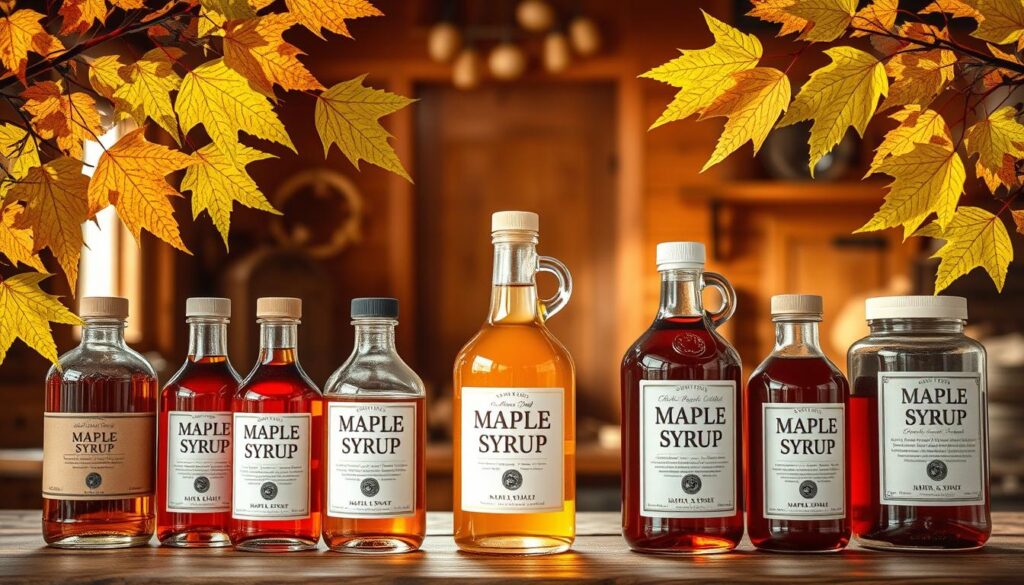
Knowing about maple syrup grades is key to picking the right natural sweetener. The grading system shows the special traits of each syrup type. This ensures you get a great flavor enhancer for your cooking.
Color Classification System
Maple syrup is sorted into four main grades by color and light:
- Golden Color, Delicate Taste: Lightest grade, with a subtle maple flavor
- Amber Color, Rich Taste: Slightly darker, with a more pronounced maple profile
- Dark Color, Robust Taste: Deep amber hue with an intense maple flavor
- Very Dark Color, Strong Taste: Darkest grade with the most robust maple character
Flavor Intensity Guide
Expert sugarmakers check the flavor of their maple syrup. The color and taste go hand in hand. Lighter syrups have milder flavors, while darker ones are more intense.
| Grade | Color | Flavor Intensity | Best Uses |
|---|---|---|---|
| Golden | Very Light | Mild | Dessert toppings, light baking |
| Amber | Light to Medium | Moderate | Pancakes, general cooking |
| Dark | Medium to Deep | Strong | Marinades, glazes |
| Very Dark | Deep Amber | Intense | Baking, robust recipes |
Choosing the right maple syrup grade makes it more than just a sweetener. It becomes a key flavor enhancer that can make any dish better.
Storage and Preservation Methods
Keeping your natural sweetener fresh is key. Maple syrup, a local favorite, needs special care to keep its taste and nutrients. Knowing how to store it right can make it last longer.
Choosing the right container is the first step. Glass or food-grade plastic is best. Metal can change the syrup’s taste.
- Keep unopened maple syrup in a cool, dark pantry
- Refrigerate after opening to prevent spoilage
- Store at temperatures between 32-40°F for optimal preservation
Maple syrup can last a year if stored right. Once opened, it needs to be refrigerated. Cold keeps it fresh and prevents mold.
Freezing is great for long-term storage. It stops crystals from forming and keeps the taste. Just put it in a freezer-safe container, leaving room for expansion.
Professional sugarmakers say to check stored maple syrup often for spoilage or mold.
Signs of maple syrup going bad include:
- Unusual odor
- Visible mold growth
- Significant color changes
By following these tips, you can enjoy your maple syrup for months.
Economic Impact on Local Communities
Maple syrup production is a key economic driver for rural areas in the United States. It keeps traditional farming alive and brings in a lot of money for local farmers.
The maple syrup industry shows how local products can boost rural economies. Small sugarmakers play a big role in making these areas more stable. They create jobs and help communities grow.
Job Creation and Rural Development
Maple syrup production offers many jobs in rural areas:
- Direct harvesting and production roles
- Equipment manufacturing
- Transportation and logistics
- Marketing and sales professionals
- Tourism and hospitality services
Market Growth Statistics
The maple syrup market is growing fast, showing its big role in green farming:
| Year | Production Value | Jobs Created |
|---|---|---|
| 2018 | $141 million | 3,200 |
| 2020 | $186 million | 4,500 |
| 2022 | $221 million | 5,700 |
These numbers show how big maple syrup is as a local product sector.
Seasonal Considerations and Best Time to Buy
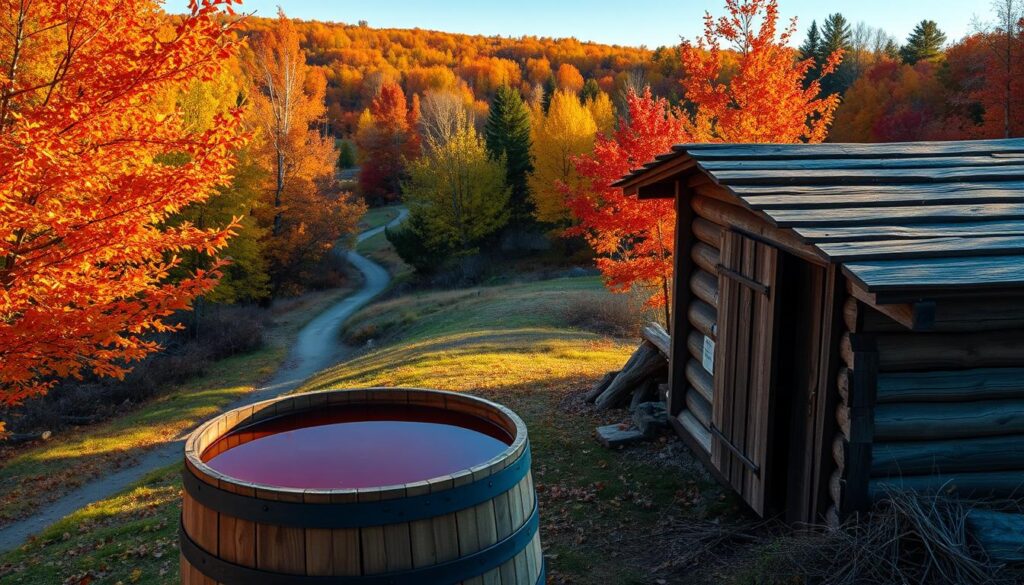
Maple syrup production is a dance with nature, tied to local produce and seasons. It turns tree sap into natural sweetener during a short window each year. This usually happens from late winter to early spring.
The maple syrup harvest season, or sugaring, happens when it’s cold at night and warm during the day. This mix of temperatures makes the sap flow in maple trees. It’s the perfect time to collect this liquid gold.
- Peak harvest season: Late February to early April
- Optimal temperature range: 40°F during day, 20°F at night
- Typical harvest duration: 4-6 weeks
Local producers know how weather affects syrup quality. Each area has its own maple syrup production time. It’s important to find nearby sugarmakers.
| Region | Typical Harvest Weeks | Average Production |
|---|---|---|
| Northeast USA | Mid-March to Early April | 40-50 gallons per acre |
| Midwest | Late February to Mid-March | 30-40 gallons per acre |
| Canada | Early March to Late April | 50-60 gallons per acre |
To get the best maple syrup, buy it from local producers during or right after harvest. Fresh syrup tastes better and is more nutritious.
Common Misconceptions About Maple Syrup
Maple syrup often gets a bad rap due to misunderstandings. People think it’s not as healthy as other sweeteners. This is because they don’t know the truth about its nutritional value and how it’s made.
To understand maple syrup better, we need to sort out fact from fiction. It’s actually better than honey in many ways. Let’s take a closer look.
Debunking Popular Myths
- Myth: Maple syrup is just sugar
Reality: Pure maple syrup has minerals and antioxidants. These give it nutritional benefits that sugar doesn’t have.
- Myth: All maple syrups are the same
Reality: There are different grades of maple syrup. Each has its own flavor and nutritional profile.
- Myth: Maple syrup is unhealthy
Reality: Maple syrup is healthier than many other sweeteners. It’s okay to have it in moderation.
Scientific Evidence
| Misconception | Scientific Findings |
|---|---|
| No Nutritional Value | Contains zinc, manganese, calcium, and antioxidants |
| High Sugar Content | Lower glycemic index compared to regular sugar |
| Artificial Processing | Natural extraction from maple tree sap with minimal processing |
Research keeps showing that maple syrup is special. It challenges old myths about this natural sweetener.
Alternative Uses Beyond Cooking
Maple syrup is more than just for breakfast. It has surprising uses that can change how we live and care for ourselves.
Maple syrup is a versatile ingredient. Here are some ways to use it:
- Natural Skincare: Use maple syrup as a gentle facial mask to hydrate and nourish skin
- Fitness Nutrition: Create homemade energy bars and pre-workout supplements
- Craft Beverage Mixing: Develop unique cocktails and mocktails
- Wood Conditioning: Polish wooden cutting boards and kitchen utensils
Health lovers value maple syrup for more than cooking. It’s full of minerals, making it a better choice than processed sugars for health.
“Maple syrup isn’t just food—it’s a versatile natural solution for multiple lifestyle needs.” – Maple Industry Research Institute
Maple syrup can also be used for hair care, beauty treatments, and even as a natural preservative in DIY projects.
- Hair Treatment: Create deep conditioning masks
- Natural Preservative: Use in homemade cosmetic recipes
- Aromatherapy: Develop unique natural fragrance blends
Maple syrup’s versatility inspires new uses in many areas. It shows that this natural sweetener is more than just a food item.
How to Choose High-Quality Maple Syrup
Choosing the right natural sweetener is important, and maple syrup is no exception. Fans of local produce know that not all syrups are the same. Knowing the difference can make your cooking better and ensure you get the best product.
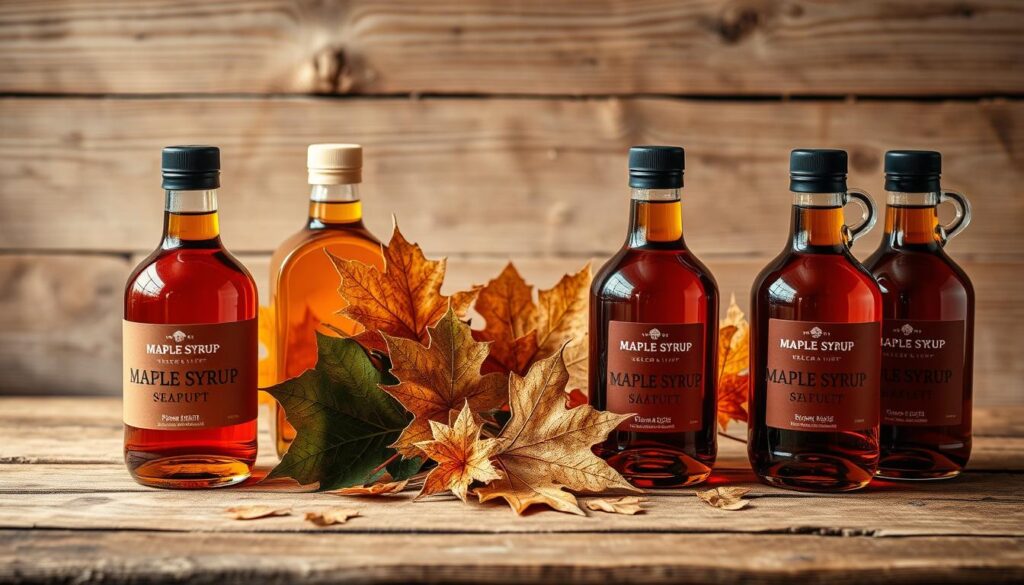
- Check the color and grade – lighter syrups have a milder taste
- Make sure it’s from a trusted local producer
- Choose pure, single-source maple syrup without extra ingredients
- Look for packaging with authenticity stamps
Authentication Methods
True maple syrup has clear signs of quality. It should have:
- Info about the sugarmaker
- Where it was made
- The date it was harvested
- Official stamps of approval
Price vs Quality Considerations
Price can hint at quality, but it’s not the only factor. Making maple syrup is hard work. So, expect to pay more for top-notch, locally made syrup.
Pro tip: A slightly higher price often reflects the careful craftsmanship behind true maple syrup.
Trust your senses when picking maple syrup. Good syrup should taste rich and complex, showing its careful making and unique place of origin.
Conclusion
Exploring natural sweeteners shows maple syrup as a top choice. It’s packed with nutrients and made in a way that’s good for the planet. This makes maple syrup a standout in both taste and health.
Maple syrup has more than just sweetness. It’s full of minerals, antioxidants, and trace elements. This is thanks to the careful work of sugarmakers who use old and new methods to make it.
Cooks and health lovers see the value in maple syrup. It adds flavor and nutrition to many dishes. Its low glycemic index and minerals make it a better sweetener choice.
More people are choosing maple syrup for its real production, health perks, and taste. It’s a natural sweetener that’s more than just sugar. By picking maple syrup, you support green farming and enjoy a special taste.

